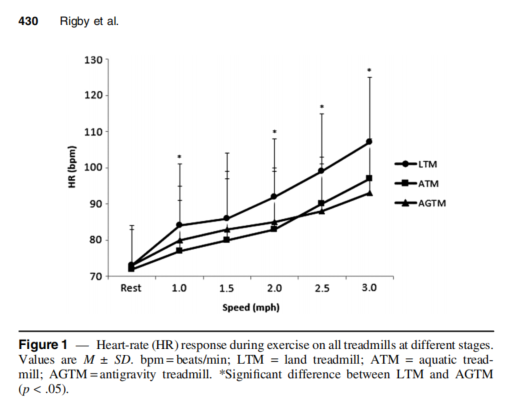The purpose of this study was to compare acute cardiometabolic responses to 3 modes of treadmill exercise in adults diagnosed with Parkinson’s disease (PD).
Eight elderly adults with PD (67.9 ± 3.0 yr) completed 1 session each on a land, aquatic, and antigravity treadmill at 50% body weight. Participants walked from 1 to 3 mph in 0.5-mph increments at 0% grade for 5 min at each speed. Heart rate, energy expenditure, blood pressure, and rating of perceived exertion were measured at rest and during exercise. All variables except diastolic blood pressure increased with speed on all treadmills (p < .001). At all speeds except 1.5 mph, heart rate was higher on the land treadmill than the antigravity treadmill (p < .05). Exercising on an aquatic or antigravity treadmill elicits similar submaximal physiologic responses to exercise on a land treadmill in adults with PD.
Article cited in: Adapted Physical Activity Quarterly, 2018, 35, 424–436
Article quoted in: Acute Cardiometabolic Responses to Three Modes of Treadmill Exercise in Older Adults With Parkinson’s Disease
Parkinson’s disease (PD) is a chronic, progressive, neurological disorder caused by the destruction of dopamine-producing neurons in the substantia
nigra of the brain (Jacobs, Svoboda, & Lepeley, 2018). It is the most common neurodegenerative disease that affects movement and is prevalent in 1% of elderly persons aged 60 years or older (Ravina et al., 2003; Snyder & Adler, 2007). Individuals diagnosed with PD often exhibit muscle tremors and rigidity, bradykinesia, and altered postural control and gait (Jacobs et al., 2018). Dysfunctional gait patterns are typically observed in those with PD due to decreased step length (Morris, Huxham, McGinley, Dodd, & Iansek, 2001; Sofuwa et al., 2005) and foot clearance (Myers & Nieman, 2010), increased shuffling of the feet from the loss of proper heel-strike and toe-off gait phases, decreased or absent arm swing (Myers & Nieman, 2010), reduced lower body muscle strength, and an abnormal coordination between limbs (Winogrodzka, Wagenaar, Booij, & Wolters, 2005).

Discussion:Exercise on an ATM or Anti-gravity Treadmill might be appropriate alternatives to exercise on a LTM for adults with PD. The physiological adaptations and changes in functional outcomes to exercise on an ATM in those with PD have not been previously defined. However, differences between functional outcomes following long-term interventions while walking on an Anti-gravity Treadmill versus other exercise modalities have been recently summarized in adults with PD. Most protocols in existing research studies include the use of a partial body weight-supported treadmill (PWSTT) that has similar weight-unloading characteristics when compared with an Anti-gravity Treadmill . Gait performance, balance, and scores on the Unified Parkinson Disease Rating Scale were similarly improved following 4 weeks (16 sessions total) each on an Anti-gravity Treadmill and while free walking with arm swinging strategies.
The acute cardiovascular and metabolic responses to submaximal exercise on an LTM, ATM, and Anti-gravity Treadmill are similar in elderly individuals diagnosed with PD. The inherent pathophysiology of PD may cause postural instability and gait abnormalities, thus increasing the risk of future falls. Walking on an ATM or Anti-gravity Treadmill may therefore provide a more appropriate environment to elicit cardiometabolic responses when compared with a traditional LTM if prescribing aerobic exercise modalities to those with PD.